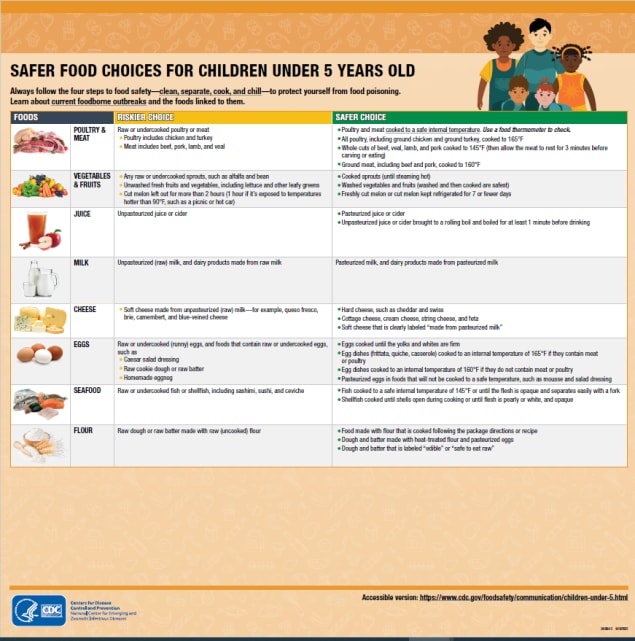Safer Food Choices for Children Under 5 Years Old
Help Prevent Food Poisoning

Young children have a higher risk of food poisoning. Their immune systems are still developing, so their bodies aren’t able to fight germs and sickness as well as adults. Food poisoning can be particularly dangerous for them because it can lead to diarrhea and dehydration.
To prevent food poisoning, some foods are safer choices than others. That’s because some foods—such as undercooked meat and eggs, unwashed fruits and vegetables, and unpasteurized milk — are more often associated with foodborne illnesses. Use the table below as a guide to safer food choices.
| Foods | Riskier Choice | Safer Choice |
|---|---|---|
Poultry and Meat
 |
Raw or undercooked poultry or meat
|
Poultry and meat cooked to a safe internal temperature. Use a food thermometer to check.
|
Vegetables and Fruits
 |
|
|
Juice
 |
Unpasteurized juice or cider |
|
Milk
 |
Unpasteurized (raw) milk, and dairy products made from unpasteurized milk | Pasteurized milk, and dairy products made from pasteurized milk |
Cheese
 |
Soft cheese made from unpasteurized (raw) milk — for example, queso fresco, brie, camembert, and blue-veined cheese |
|
Eggs
 |
Raw or undercooked (runny) eggs, and foods that contain raw or undercooked eggs, such as
|
|
Seafood
 |
Raw or undercooked fish or shellfish, including sashimi, sushi, and ceviche |
|
Flour
 |
Raw dough or raw batter made with raw (uncooked) flour |
|
Always follow the four steps to food safety—clean, separate, cook, and chill—to protect yourself from food poisoning.
Learn about current foodborne outbreaks and the foods linked to them.
